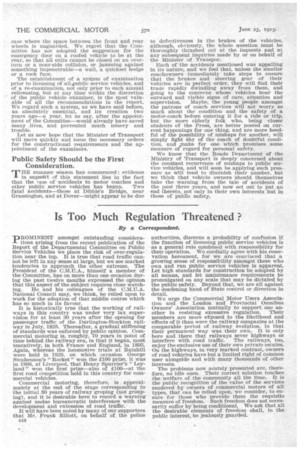Better Control of Public Service Vehicles.
Page 1

Page 2

If you've noticed an error in this article please click here to report it so we can fix it.
A T the first reading of the interim report of 1the Departmental Committee on the Licensing and Regulation of Public Service Vehicles there is a sense of disappointment which, however, tends to be dispelled on a closer acquaintance with its terms and recommendations. We had hoped to be able to deal with this report in our last issue, for the final proofs had passed out of the hands of the Ministry of Transport some days earlier, with instructions to His Majesty's , Stationery Office to expedite issue. The material, however, was released to us just too late for inclusion in The Commercial Motor without a disturbance, which was not warranted, of pages already passed for press. We mention this fact, as we have heard it unjustly said that the report was rushed out by the Ministry in a panic on the receipt of the news of the Dibble's Bridge smash.
The Committee has done good work in its historical survey of the law determining the control of public service vehicles, and even better in clearly defining the status and position of a "stage carriage" and a "public service vehicle," and by finding names for the "express carriage" and the "contract carriage," and defining those terms, thereby bringing within the scope of the projected new regulations types which have tended to escape control and regulation.
We need not trouble to deal with the proposed reduction in the number of licensing authorities, except to say that the fewer they are the better, and to express the hope that the necessary modifications in the law, made in pursuance of the proposal, shall not hicrease the power of the municipal bodies owning tramway, trolley-bus and motor-bus undertakings to repress fair competition from private undertakings. That question is too large to be dealt with at the present stage of the proposal. What is of much greater importance is the section of the report dealing with construction and maintenance of vehicles and of their examination and approval.
The proposed constructional requirements do not involve many changes. We notice that the maximum length of a vehicle must not exceed 26 ft., that the two compulsory independent brakes must now act upon the rear, wheels (frontwheel brakes, if used, will, therefore, not be accepted as one of the compulsory brakes, but mit be additional thereto), that the filling orifice of a fuel tank must be outside of the vehicle, and that a near-side lifeguard must be fitted in any case where the space between the front and rear wheels is unguarded. We regret that the Committee has not adopted the suggestion for the emergency door on a roofed vehicle to be at the rear, so that all exits cannot be closed on an overturn or a near-side collision, or jamming against something impenetrable—a wall, a quickset hedge or a rock face. The establishment of a system of examination prior to licensing of all,public service vehicles, and of a re-examination, not only prior to each annual relicensing, but at any time within the discretion of the public vehicle examiner, is the most valuable of all the recommendations in the report. We regard such a system, as we have said before, as absolutely essential, and its creation two years ago—a year, let us say, after the appointment of the Committee—would already have saved many lives, and prevented much misery and trouble. Let us now hope that the Minister of Transport will move quickly and issue the necessary orders for the constructional requirements and the appointment of the examiners.
Public Safety Should be the First Consideration.
THE summer season has commenced: evidence in supno:tt of this statement lies in the fact that the tale of • accidents to motor coaches and other public service vehicles has begun. Two fatal accidents—those at Dibble's Bridge, near Grassington, and at Dover—might appear to be due to defectiveness in the brakes of the vehicles, although, obviously, the whole Question must be thoroughly thrashed out at the inquests and at any subsequent inquiries made by or on behalf of the Minister of Tran.spor; Each of the accidents mentioned was appalling in its nature, and we feel that, unless the smaller coachowners immediately take steps to ensure that the brakes and steering gear of their vehicles are in perfect order, they will find their trade rapidly dwindling away from them, and going to the concerns whose vehicles bear the outward and visible signs of care, attention and supervision. Maybe, the young people amongst the patrons of coaeh services will not worry so much about the condition and the safety of a motor-coach before entering it for a ride or trip, but the more elderly folk who, being closer students of the Press, are better posted on current happenings for one thing, and are more heedful of the possibility of mishaps for another, will simply fight shy of the coach of doubtful condition, and Jnake for one which promises some measure of regard for personal safety. We know that the Roads Department of the Ministry of Transport is deeply concerned about the constant recurrence of mishaps to public service vehicles, and will soon be applying such pressure as will tend to diminish their number, but we think that vehicle owners -should themselves take the warning from the tale of accidents of the past three years, and now set out to put an end thereto, not only in their own interests but in those of public safety.






























